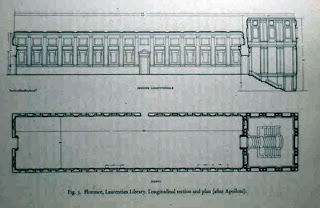Freedberg’s chapter on painting in central
Italy (1535-1575) begins by describing an emergence of Mannerism, as an
evolution not marked by any sure distinction, but more as an emotional
experimentation, as much as certain dissent from the High-Renaissance canon, by
individual artists, “initiated” by early generation and continued by the next.
High-maniera is both an exploration of potential in the work of early
mannerists, and also a highly restrictive “genre” concerned with combining a
deliberately stylized reality with artifice and ornamentation, with no room for
nonintention. These artists looked to both Michelangelo’s sculpture and
(Raphael’s as well) sculptural paintings, and to classical sculpture as part of
a new canon of painting. A purpose emerges in using/referencing older works out
of context with multiple, complex and perhaps contradictory meanings. An
extreme relationship with contemporary literature also emerges, reflecting
heavy use of metaphor and allusion, with the visual result not always fully
interpretable by the viewer. Described is the (contradictory?) quality of
duality and dislocations of the meanings in high-Manierist religious art, thus
creating a sense of (religious) excitement. Perhaps the best definition of the
best of the high-maniera work is one of many multiple (if unrelated) meanings,
skillfully applied, with extreme care with regard to aesthetics in which it was
the viewers task to synthesize meaning, bringing their own intelligence and
education to bear upon the work, and to parse a meaning of their own devising.
Freedberg points out that maniera painting is generally regarded as a “decline”
from High Renaissance, and Craig Hugh Smyth quotes others with the same regard
in his treatise.
Smyth lists nineteenth century (negative)
perceptions and attributes of mannerist painting, namely the use of Michelangelesque
forms and style. As well, the change in status of the painter from journeyman
to courtier is further blamed for the decline in quality of Mannerist works.
Problematic is the interpretation of the seemingly many forms of Mannerism, and
how these interpretations, the forms, and terms used to describe them changed
over the centuries since the Cinquecento. Derogatory comments seem to
consistently dwell upon reliance on imagination and style, rather than nature
itself. (rather opposite of our contemporary work) Conversely, changing tastes
of the Seventeenth century see mannerist work as “fantastic”, and all
characteristics are seen in an aesthetically Positive light. Further
characteristics of Mannerism are explored, such as a uniformity of figures, and a seeming canon of awkward
physical poses for figures, and a flattened light source often used, the
importance of the portrayal of minutiae, and of odd portrayals of space
(“broken” and “divided” and “not easily grasped”).
Mannerism obviously encompasses so many
different characteristics it may be impossible to define or encapsulate all
work that may fall within this loose term for the work of many artists over
decades, and whether it was deliberately anti-classical, or simply
experimentation, or whatever, it is certainly interesting, and often beautiful,
for all its strangeness.











